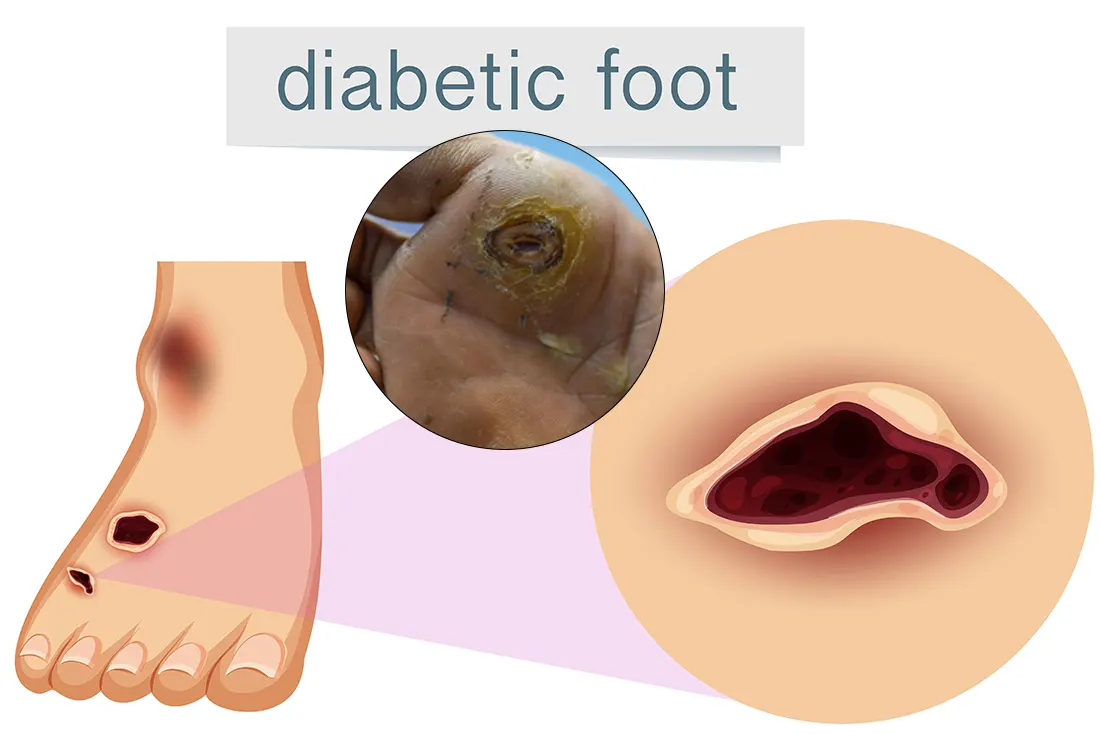-
 Mail us
Mail usinfo@myhealthhospitals.com
-
 Toll Free
Toll Free+91 9111674111
- Book Appointment
Vascular Surgery
A diabetic foot ulcer is an open sore that typically develops on the bottom of the foot due to poor circulation, nerve damage (neuropathy), or infection. Without timely medical intervention, it can progress to severe stages requiring surgical management.

Recognizing the early signs can prevent complications:
If you notice these symptoms, visit My Health Hospital Tarnaka immediately for expert diabetic foot ulcer treatment near Secunderabad.
Monitoring progress is crucial. A healing ulcer will show:
If healing stalls, advanced treatment options such as Negative Pressure Wound Therapy (NPWT) or Hyperbaric Oxygen Therapy (HBOT) may be needed.
Dr. Puneeth uses advanced surgical and enzymatic debridement to remove dead tissue and promote healing at the DFU Debridement Clinic in Tarnaka.
Customized antibiotic therapy and drainage help control infections and prevent systemic spread.
Pressure-relieving footwear, orthotics, or total contact casting reduce pressure on the ulcer and accelerate recovery.
Also known as vacuum-assisted closure, this method removes fluids and bacteria while stimulating new tissue growth—ideal for non-healing diabetic wounds in Hyderabad.
At My Health Hospital Tarnaka, Hyperbaric Oxygen Therapy for DFU enhances oxygen supply to tissues, promoting faster healing and reducing infection risk.
Dr. Puneeth Joopalli specializes in limb salvage procedures, restoring blood flow and preventing amputation in advanced DFU cases.
Dr. Puneeth emphasizes early diagnosis and preventive diabetic foot care to avoid these advanced stages.
Prevention is always better than cure. Key tips include:
Caused by nerve damage—managed using pressure offloading and custom orthotics.
Caused by poor blood flow—treated with angioplasty, stenting, or bypass surgery to restore circulation.
At My Health Hospital, patients receive:
With Dr. Puneeth Joopalli’s expertise and the hospital’s cutting-edge technology, patients can expect high-success outcomes and minimized amputation risk.
Seek medical help if you experience:
Delaying care increases the risk of limb loss. Timely treatment at My Health Hospital ensures the best possible recovery.
Diabetic foot ulcers require expert attention and advanced medical management to avoid severe complications. At My Health Hospital, Tarnaka – Secunderabad, Dr. Puneeth Joopalli leads specialized DFU care using state-of-the-art technology and evidence-based protocols. Whether it’s non-healing wound management, negative pressure wound therapy, or limb salvage surgery, his expertise ensures the best outcomes for every patient.
If you or your loved one is facing a diabetic foot problem, don’t delay treatment.
📍 Visit My Health Hospital, Tarnaka, Secunderabad
📞 Call 9100001201 for appointments or emergency DFU care.
Minor ulcers may heal within 3–6 weeks, while deeper or infected ulcers can take several months. Healing time depends on blood-sugar control, infection status, and circulation quality. Regular follow-up at My Health Hospital, Tarnaka ensures better recovery.
Yes. Early-stage ulcers (Grade 1 or 2) can often heal without surgery using offloading devices, proper wound dressing, and infection control. However, advanced cases might require debridement or limb salvage surgery.
A vascular surgeon like Dr. Puneeth Joopalli plays a vital role in restoring blood flow through procedures such as angioplasty, bypass, or endovascular interventions. This improves oxygen supply to tissues and helps prevent amputation.
Yes, with daily foot inspections, proper footwear, regular blood-sugar monitoring, and timely visits to a diabetic foot specialist in Tarnaka, DFUs can be largely prevented.
Common signs include redness, swelling, pus discharge, foul odor, or fever. These symptoms indicate a severe diabetic foot infection requiring immediate attention from a DFU specialist near Secunderabad.
Non-healing ulcers often need advanced wound care, including Negative Pressure Wound Therapy (NPWT), Hyperbaric Oxygen Therapy (HBOT), and vascular evaluation to restore circulation.
Signs of healing include reduced wound size, less drainage, and formation of healthy red tissue. Regular dressing changes and check-ups at the Wound Healing Center in Tarnaka help monitor progress effectively.
If you notice slow-healing wounds, blackened skin, pain, or numbness in your foot, consult Dr. Puneeth Joopalli immediately. Early diagnosis and timely DFU treatment can help prevent amputation and restore healthy mobility.
If you cannot find answers to your queries, please fill out the ENQUIRY form or call the number below. We will contact you shortly
+91 9100001201